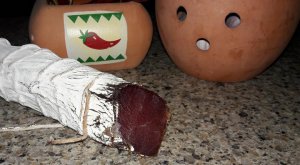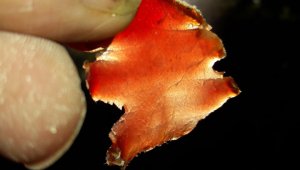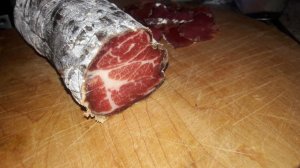Well everything seems to be going smoothly. This picture shows the lonza after 7 days and the coppa after 5. Today the coppa is starting to get a nice coat on it. I have my humidity and temp set where I want them. 75%RH at 55degs. I check everyday and the opening of the door adds a little airflow as does the refrigerator when the condenser kicks on. Because of the size 3.5lbs for the coppas and 1.75 for the pork tenderloin I'm thinking around 6 - 8 weeks to loose 30-35% weight. Hope they taste good. Made a lonza last year by just fermenting in salt and washing in wine, rubbing in black pepper, wrapping in a brown bag, trussing and hanging in my basement in the winter. Because I had low humidity it had a hard outside but the taste and inside were quite good. Hope these are substantially better.


Coppa and Lonza
- Thread starter Gweeto
- Start date
-
Some of the links on this forum allow SMF, at no cost to you, to earn a small commission when you click through and make a purchase. Let me know if you have any questions about this.
You are using an out of date browser. It may not display this or other websites correctly.
You should upgrade or use an alternative browser.
You should upgrade or use an alternative browser.
SMF is reader-supported. When you buy through links on our site, we may earn an affiliate commission.
Thank you. Will post more as we get closer and when I slice into them. Looking forward to slicing them thin and putting them on my pizza topped with arugula and a drizzle of olive oil. My brother and I built an outdoor oven 5 years ago and we enjoy making home made items that are fresh that can be used as toppings. These will truly be on the top of the list.Good Eats.
I was just going to ask....how do you plan to eat these...i hope you like them as cold cuts not just as pizza topping.
It seems an awful lot of labour if you don't enjoy them on their own.
It seems an awful lot of labour if you don't enjoy them on their own.
That is living. But we live everyday not just on Fridays. :-)Oh without a doubt. I love all types of cured meats. A Friday after work with some home made wine, a plate of cheese and cured meats.......now that's living.
Damn right.LOL how true. Always like to look forward to something. "Eye one the prize".
Well the first lonza was tasted last night out of my curing chamber. Last year tried it by fermenting and hanging in a basement at 50+ degs. Low humidity made the outside quite hard. Once yo got to the meat it was good. This 404gram tenderloin cured in a little over 3 weeks and is moist yet firm on the outside. I brushed off the mold just on the part I tasted so as not to eat the whole thing. Only thing I will do different next time is do a 1 day per lb for the fermentation. I kept this in for 1 week and it is a little too salty for my taste. Also I will not add juniper to the recipe. Great in my gin but not the lonza. Another week and my first coppa should be ready.
Attachments
About the saltiness of the meat....
From what I have read, adding 2.75% Kosher salt and 0.25% cure, makes for about the minimum salt necessary for a product that can be expected to be a bacteria/pathogen free zone... Some say 3% salt, others say 3.25%-3.5% salt...
Soooo, take those numbers for what they are worth, to you, as a dried meat maker....
From what I have read, adding 2.75% Kosher salt and 0.25% cure, makes for about the minimum salt necessary for a product that can be expected to be a bacteria/pathogen free zone... Some say 3% salt, others say 3.25%-3.5% salt...
Soooo, take those numbers for what they are worth, to you, as a dried meat maker....
My first coppa was ready yesterday and I had some of my friends over for the unveiling. I have to say it was really good. the taste of black pepper and cayenne was perfect. The second is almost ready. Just wish they had bigger beef bungs so i could put the whole coppa inside rather than having to cut it length wise. I may try not encasing it and just putting it in a net. Any thoughts on that.
Attachments
Thank you for the information. I think that is a great idea. Now when you say the inoculation chamber.....the pail shot from above..... is that where you hold the temp at about 80degs at 80% or above RH for 24 hrs and then into the curing chamber. If that is the case I did that in my curing chamber by raising the inside tempt to 80degs with a heater and then dropping it to 55 deg 65-70%RH. How long do you ferment the meat with the herbs on it for? I did a week on a 3.5lb coppa and the same for a 2.25lb lonzino. I probably should have done 1 day per lb as i have read because the Lonza is a tad salty. Any thoughts on that. Again I enjoyed seeing and reading your reply. OH I noticed you are using the same knife I have. lol. Looking to buy a meat slicer but I don't want to spend a ton but also don't want to get a piece of junk. Any suggestions. One last thing.......did you use Cure#1 or #2
Is your inoculation chamber the shot from above the pail and if so is that kept at around 80% with 80+RH for 24 hrs?I have made bresaola and am now making lonzino and will not case them for aging. Simply spritz the surface of the meat with bactroferm 600 into the inoculation chamber for a couple days for mold to establish then into the curing chamber.
From what I've read the beef bung control the moisture loss. This is probably more a necessity when relying on a natural curing environment but with a curing chamber running slightly higher humidity levels can do the same thing.
While I'm not opposed to using beef bungs unless someone has information that casing really effects the quality/taste of the end product I'm quite happy just trussing, inoculating, aging w/o casing and saving a few dollars.
1st pic is a uncased bresaola in the curing chamber after about 1 month
2nd pic is the same bresaola brushed of mold (it ended up being about 10g worth) and sliced in 1/2
3rd pic is the bresaola after 48 hours in the inoculation chamber where the mold is just starting to establish. They were then moved to the curing chamber where within 8 hours of this picture I had 90% coverage with a white heavy frost of mold. An additional 24 hours later the bresaola was 99% covered and the heavy coating of mold was starting to encompass the trussing.
Curing chamber running at 55 degrees F and 70% RH for the duration of the aging process.
View attachment 366161 View attachment 366162
I do that in my curing chamber and then lower the temp and RH for the remainder of the time. How long do you ferment for. I did 1 week for a 3.5lb coppa and a 2.25lb lonza and the lonza was a little too salty for my liking. I should probably do 1 day per lb as I have read. Any thoughts. Also did you use cure#1 or #2. This may be a redundant reply but I didn't see the last one posted. Like the knife in the picture.......use the same one. Thank you for the pictures and information.
How long do you ferment for. ...
Gweeto, afternoon.... Fermentation of meats is a different animal from curing / drying to a water content, salt content, nitrite/nitrate content, that will not support bacterial growth..
Fermentation includes the use of a bacterial culture, specific to a region, (Italy, Cypress, France etc.) that provides an end result equal to that of the region to achieve a specific flavor in the meat... OR, natural bacteria of your region works also.. Some fermentation bacteria acidify the meat to kill bacteria by lowering the pH..
Beneficial Bacteria
Without beneficial bacteria it will not be possible to make fermented sausages, yogurt, saurkraut, cheese or wine.. They are naturally occurring in foods and meat meat, but in most cases they are added into the meat in the form of starter cultures. There are two classes of beneficial (friendly) bacteria:
Lactic acid producing bacteria - Lactobacillus, Pediococcus.
Color and flavor forming bacteria - Staphylococcus, Kocuria (previously known as Micrococcus).
Although lactic acid producing bacteria are used mainly to produce fermented products, color and flavor forming bacteria are needed to brake Nitrate into nitrite and are often added to develop a stronger red color of meats.
pH and Sausages Bacteria prefer meats with a pH of 6.0 -7.0 which falls in the neutral range of the pH scale. It is in our interest to increase the meat acidity (lower pH) as this inhibits the growth of bacteria. As a result the sausage is stable and safe to consume, although it has not been submitted to heat treatment, which in many cases follows anyhow. A pH drop is accomplished by lactic acid bacteria, which consume sugar and produce lactic acid. This increases the acidity of the meat. The acidity can also be increased by directly adding additives to the meat such as Gdl (glucono-delta-lactone) and/or citric acid.
Marianski, Stanley; Marianski, Adam. The Art of Making Fermented Sausages (Kindle Locations 99-104). Bookmagic LLC. Kindle Edition.
Charcuterie, drying meats is like making jerky, only in a highly sophisticated sense... A 3 or 4# single muscle hunk of meat takes some serious attention to detail... drying to fast makes the outside like shoe leather and will not allow the meat inside to adequately dry to a "bacteria kill zone"... Humidity, temperature and air changes are a BIG DEAL...
Single muscles are considered sterile on the inside and THAT makes them ideal for drying...
Well, that's the short version... Don't take any of this personal... When I see a question that I think is ambiguous, I dive into an explanation so others can get some sort of an idea what this is all about... Maybe they will search out the different methods and have a valuable learning experience..
Gweeto, afternoon.... Fermentation of meats is a different animal from curing / drying to a water content, salt content, nitrite/nitrate content, that will not support bacterial growth..
Fermentation includes the use of a bacterial culture, specific to a region, (Italy, Cypress, France etc.) that provides an end result equal to that of the region to achieve a specific flavor in the meat... OR, natural bacteria of your region works also.. Some fermentation bacteria acidify the meat to kill bacteria by lowering the pH..
Beneficial Bacteria
Without beneficial bacteria it will not be possible to make fermented sausages, yogurt, saurkraut, cheese or wine.. They are naturally occurring in foods and meat meat, but in most cases they are added into the meat in the form of starter cultures. There are two classes of beneficial (friendly) bacteria:
Lactic acid producing bacteria - Lactobacillus, Pediococcus.
Color and flavor forming bacteria - Staphylococcus, Kocuria (previously known as Micrococcus).
Although lactic acid producing bacteria are used mainly to produce fermented products, color and flavor forming bacteria are needed to brake Nitrate into nitrite and are often added to develop a stronger red color of meats.
pH and Sausages Bacteria prefer meats with a pH of 6.0 -7.0 which falls in the neutral range of the pH scale. It is in our interest to increase the meat acidity (lower pH) as this inhibits the growth of bacteria. As a result the sausage is stable and safe to consume, although it has not been submitted to heat treatment, which in many cases follows anyhow. A pH drop is accomplished by lactic acid bacteria, which consume sugar and produce lactic acid. This increases the acidity of the meat. The acidity can also be increased by directly adding additives to the meat such as Gdl (glucono-delta-lactone) and/or citric acid.
Marianski, Stanley; Marianski, Adam. The Art of Making Fermented Sausages (Kindle Locations 99-104). Bookmagic LLC. Kindle Edition.
Charcuterie, drying meats is like making jerky, only in a highly sophisticated sense... A 3 or 4# single muscle hunk of meat takes some serious attention to detail... drying to fast makes the outside like shoe leather and will not allow the meat inside to adequately dry to a "bacteria kill zone"... Humidity, temperature and air changes are a BIG DEAL...
Single muscles are considered sterile on the inside and THAT makes them ideal for drying...
Well, that's the short version... Don't take any of this personal... When I see a question that I think is ambiguous, I dive into an explanation so others can get some sort of an idea what this is all about... Maybe they will search out the different methods and have a valuable learning experience..
SmokingMeatForums.com is reader supported and as an Amazon Associate, we may earn commissions from qualifying purchases.
Similar threads
- Replies
- 18
- Views
- 2K
Hot Threads
-
Spammer PMs, Anybody Else?
- Started by chilerelleno
- Replies: 66
- Blowing Smoke Around the Smoker.
-
Lost my dad yesterday
- Started by normanaj
- Replies: 40
- Blowing Smoke Around the Smoker.
-
On the Edge of Trying Sausage Making
- Started by BrianGSDTexoma
- Replies: 35
- Sausage
-
Took a stroll this afternoon
- Started by Buckeyedude
- Replies: 33
- Field and Stream
-
Featured Blackened Rockfish...
- Started by Gonna Smoke
- Replies: 33
- Fish







